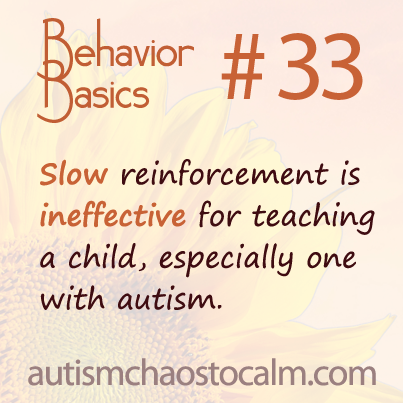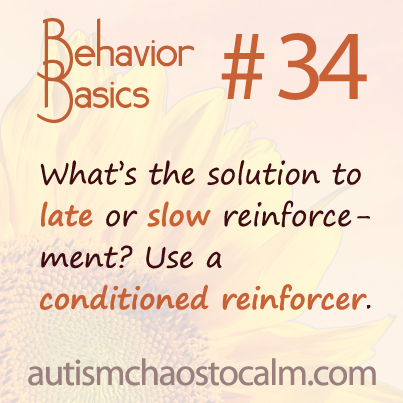 33. Slow reinforcement is ineffective for teaching a child, especially one with autism.
33. Slow reinforcement is ineffective for teaching a child, especially one with autism.
A child with autism lives in the moment. He is keenly aware of what is happening right now, and often, right now he has at least three or four behaviors (physical movements) going on simultaneously. Those movements change very quickly—every few seconds he’s doing other actions. Let’s say the child momentarily does one action that you wish to reinforce, so you run over and say, “Hey, good boy for doing that,” and hand out a treat. I timed myself walking a distance of 12 feet, saying, “Hey, good boy for doing that,” and handing over a treat. It took 4 seconds. In those 4 seconds, a child with autism has performed many more movements and is thinking about those new movements. The one you liked, that happened about 5 or 6 seconds ago, is history. So if you walk over to your child, praise him and hand over a treat, you are too slow and too late. The child won’t know what you reinforced. He won’t know what you want him to do again. Your reinforcement will be ineffective because it is not paired precisely with the desired behavior. Effective reinforcement is timely, on-time, and precise information. It tells the child, “That thing you are doing right now is great. Do it some more.” Our voices and words, of which we are so enamored, are slow, clumsy and too late to give exact, pinpoint information to the child. So, help the child out. Make sure that, during the time that he is doing a desired action, he gets the information, “YES. That’s right,” and now a treat is on the way. See Behavior Basic #34 for more information.
 34. What’s the solution to late reinforcement? Use a conditioned reinforcer.
34. What’s the solution to late reinforcement? Use a conditioned reinforcer.
In Behavior Basic #33 we discussed the fact that a child with autism needs pinpoint accuracy of reinforcement in order to know that he should do a behavior again. We cannot provide such speedy, accurate reinforcement with our slow voices or confusing gestures. An excellent way to provide fast, timely information to the child is with an acoustical signal, a “tag,” or click-sound, made by a tagger. The best way to reinforce a child is when he is actually doing the behavior you want — to reinforce in that “right now” micro-second. How can you reinforce so quickly? With a TAGteach tagger. A tagger allows you to provide split-second information to the child while he is performing the desired behavior. So the procedure is: observe child, tag desired behavior, give treat. By following up each tag with a treat, the tag becomes a “conditioned reinforcer.” When the child hears the tag, he knows a treat is coming his way. Eventually, the sound of the tag is reinforcing in and of itself. He learns to listen for the tag, think about what he was doing that earned the tag, and then perform the behavior again—because it brought about a pleasant consequence. Precise, timely reinforcement builds behaviors faster. There is nothing else like it.
 REMINDER: This concludes the wrap-up of Behavior Basics for the week. Please remember the schedule: On the release date of each module, the Behavior Basics for that module will be compiled into a PDF ebook available from our blog and Facebook page. Click on this link to download the entire series of 42 Behavior Basics for free: http://statictab.com/m7bizwt.
REMINDER: This concludes the wrap-up of Behavior Basics for the week. Please remember the schedule: On the release date of each module, the Behavior Basics for that module will be compiled into a PDF ebook available from our blog and Facebook page. Click on this link to download the entire series of 42 Behavior Basics for free: http://statictab.com/m7bizwt.